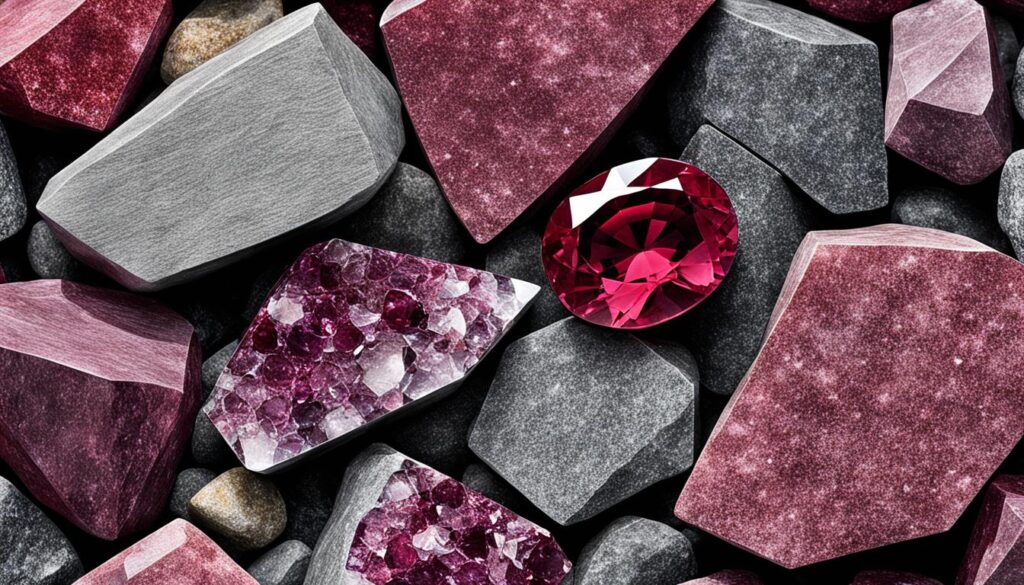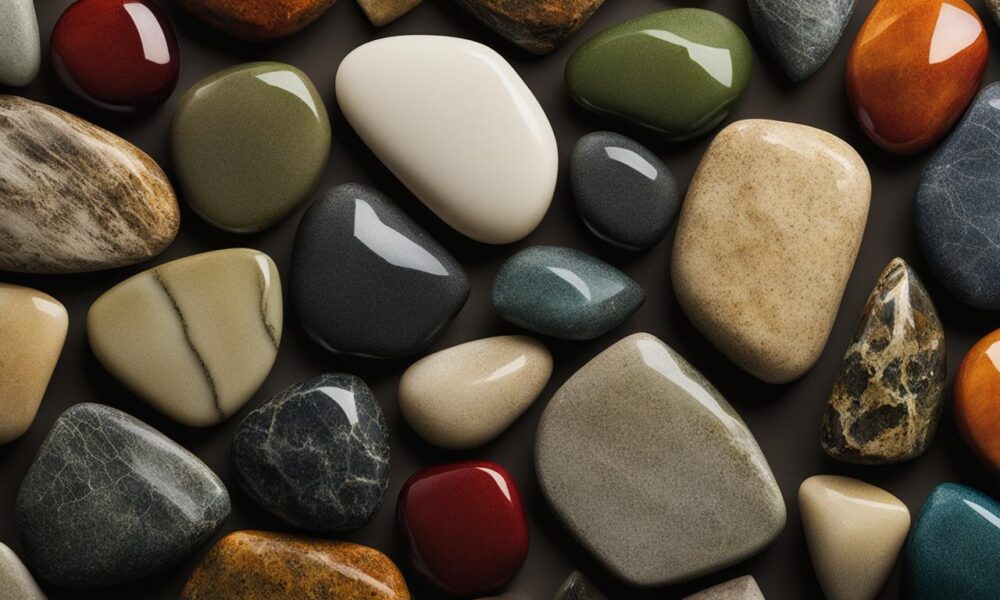Discover Earth’s Most Beautiful Natural Stones
Gemstones and minerals come in a wide variety of colors and patterns, captivating stone enthusiasts around the world. From golden yellow wulfenite crystals to iridescent ammonite shells, nature’s creations never fail to amaze. Let’s explore some of the most beautiful natural stones found in the world, showcasing their unique features and extraordinary beauty.
Key Takeaways:
- Explore the breathtaking natural stone collection that Earth offers.
- Discover stunning natural stone formations that showcase nature’s artistic mastery.
- Be captivated by the unique features and extraordinary beauty of these natural stones.
- From golden yellow wulfenite crystals to iridescent ammonite shells, witness the wonders of nature’s creations.
- Embark on a journey to appreciate the beauty and diversity of the Earth’s most beautiful natural stones.
Wulfenite & Mimetite – Vibrant Golden Crystals
When it comes to captivating gemstones, few can rival the vibrant beauty of wulfenite and mimetite. These stunning minerals showcase a brilliant golden yellow color that is truly awe-inspiring.
Wulfenite crystals, with their striking hue, often grow alongside mimetite minerals, creating a breathtaking display of color and form. The combination of these two minerals is a true marvel of nature’s artistry.
The golden crystals of wulfenite and mimetite can be found in various locations around the world, including the famous mines of Arizona, Mexico, and Morocco. These gems have become highly sought after by collectors and enthusiasts alike.
Whether admired in a museum or cherished in a personal collection, wulfenite and mimetite showcase the unparalleled beauty of golden crystals. Their vibrant color and unique features make them a true treasure of the Earth.
The Golden Crystals of Wulfenite and Mimetite
“The vibrant golden yellow color of wulfenite and mimetite is truly mesmerizing. These gemstones are a true marvel of nature’s artistry.”
- Unique combination of colors
- Striking golden yellow hue
- Found in Arizona, Mexico, and Morocco
- Highly sought after by collectors
Silver – Nature’s Shining Metal
Silver, a naturally occurring metal, showcases its beauty in the form of “silver trees” and other intricate formations. This shiny metal adds a touch of elegance and sophistication to any natural stone collection.
When it comes to natural metals, silver truly stands out. Known for its lustrous shine, silver has been prized by humans for centuries due to its beauty and versatility. From jewelry and ornaments to tableware and decorative items, silver has been admired and cherished for its aesthetic appeal.
One of the unique characteristics of silver is that it tarnishes over time, developing a patina that adds depth and complexity to its appearance. While some may see tarnishing as a flaw, others appreciate the natural aging process of silver, considering it part of the metal’s charm.
In nature, silver can be found in various forms, often forming intricate and captivating structures. One such example is the formation of “silver trees,” where silver crystals resemble delicate branches extending from a central base. These remarkable formations showcase the inherent beauty and elegance of silver, capturing the imagination of those who encounter them.
Symbolism and Significance of Silver
Throughout history, silver has held special meaning and symbolism in different cultures around the world. In many societies, silver is associated with purity, clarity, and reflection. It is often used to represent the moon, feminine energy, and intuition.
“Silver reflects the light, just as the moon reflects the sun. It symbolizes the ebb and flow of life, the balance between darkness and illumination.”
Many believe that silver possesses mystical properties, such as warding off negative energies and enhancing psychic abilities. It is also associated with wealth and prestige, as silver has often been used as currency throughout human history.
Whether treasured for its visual appeal or its symbolic significance, silver remains a timeless natural metal that continues to captivate and inspire.
| Properties of Silver | |
|---|---|
| Metal Type | Silver (Ag) |
| Atomic Number | 47 |
| Color | Shiny, silver-white |
| Appearance | Polished, reflective |
| Melting Point | 961.8°C (1763.2°F) |
| Hardness | 2.5-3 on the Mohs scale |
| Symbolic Meanings | Purity, intuition, reflection, wealth |
With its natural beauty and rich symbolism, silver continues to enchant and inspire individuals who appreciate the wonders of nature and the allure of precious metals.
Iris Agate – A Colorful Display
Iris agate is a gemstone that displays a mesmerizing array of colors, ranging from blues and purples to greens and even hints of red. This stunning natural stone is a true marvel of nature’s artistry.
“The vibrant colors of iris agate are captivating and truly breathtaking. Each stone is a unique masterpiece, showcasing nature’s endless creativity.”
Iris agate is highly prized for its mesmerizing play of colors. It is formed through a process of silicon dioxide deposition, resulting in the formation of thin layers that diffract light and create a stunning display of vibrant hues.
It is often used in jewelry making, where its colorful beauty can be appreciated in various forms such as pendants, earrings, and rings.
Here are some key features of iris agate:
- Ranges of vibrant colors, including blues, purples, greens, and hints of red
- Natural play of colors due to the unique layering structure
- Hardness rating of 6.5-7 on the Mohs scale
- Translucent to opaque appearance
- Popular for jewelry making and gemstone collections
The mesmerizing beauty of iris agate makes it a popular choice for gemstone enthusiasts and collectors alike. Its colorful display is truly captivating, adding a touch of natural wonder to any jewelry piece or gemstone collection.
Aquamarine – The Helix of the Sea
Aquamarine, named after its resemblance to the blue-green hues of the sea, is a sea-inspired gemstone that captures the essence of the ocean and its ever-changing beauty. What sets aquamarine apart is its unique helix-shaped formation, adding a touch of elegance and intrigue to its already enchanting appeal.
With its mesmerizing color and graceful shape, aquamarine has become a popular choice for jewelry and gemstone collectors alike. Its soothing blue-green tones evoke a sense of calmness and tranquility, reminiscent of the sea’s vast expanse.
“Aquamarine is the perfect gemstone for those seeking a sea-inspired aesthetic. Its cool tones and flowing shape create a sense of serenity and connection to nature.” – Gemstone Expert
One of the fascinating aspects of aquamarine is its connection to mythology and folklore. Ancient cultures believed that these sea-inspired gemstones held the power to calm rough seas and protect sailors on their journeys. Today, aquamarine continues to symbolize courage, peace, and open communication.
The Unique Helix-Shaped Formation
The helix-shaped formation of aquamarine is truly a marvel of nature. As the gemstone grows, it forms beautiful long hexagonal prisms with a spiral twist. This distinctive structure enhances the gemstone’s visual appeal and creates a captivating play of light and color.
When light enters the helix-shaped structure, it reflects and refracts within the gemstone, producing a phenomenon known as adularescence. This optical effect resembles the gentle shimmer of sunlight dancing on the surface of water, further enhancing the sea-inspired beauty of aquamarine.

| Aquamarine | Properties |
|---|---|
| Color | Blue-green |
| Cut | Various shapes and sizes |
| Hardness | 7.5-8 on the Mohs scale |
| Origin | Primarily Brazil, but also found in other parts of the world |
| Symbolism | Courage, peace, open communication |
Whether worn as jewelry or admired in its raw form, aquamarine’s sea-inspired aesthetics and unique helix-shaped formation continue to captivate and inspire. Its timeless beauty serves as a reminder of the wonders that the natural world has to offer.
Opal – The Play of Colors
Opal is a gemstone renowned for its mesmerizing play of colors. With its rainbow-like sheen, opal showcases a captivating array of hues, making it a highly sought-after choice for both jewelry enthusiasts and collectors alike.
Opals are formed from a combination of silica and water, and their unique internal structure diffracts light, resulting in a stunning display of colors. As light enters the gemstone, it interacts with the silica spheres within the opal, causing the wavelengths to diffract and separate. This phenomenon, known as “play of colors,” creates a dynamic range of spectral colors that seem to dance and shift as the gemstone is moved.
Opals can exhibit a wide variety of colors, including vibrant reds, blues, greens, and oranges. Some opals display a predominance of a single color, while others feature a mesmerizing play of multiple colors. The intensity and arrangement of colors within each opal are unique, making each gemstone a one-of-a-kind piece of natural art.
Opal is highly valued for its extraordinary play of colors, and its allure is often enhanced by skilled lapidary artisans who carefully shape the gemstone to emphasize its vibrant hues. Whether set in a ring, pendant, or earrings, opal jewelry captures attention and adds a touch of ethereal beauty to any ensemble.
“Opals are like a mesmerizing kaleidoscope of colors, each stone revealing its own enchanting dance of spectral beauty.” – Gemstone Collector
Opals are also treasured for their symbolic meanings. In ancient folklore, opal was believed to possess magical qualities that brought good luck, courage, and creativity to its wearer. Today, opal is often associated with inspiration, imagination, and emotional healing.
Red Beryl – A Rare and Valuable Gem
Red beryl, one of the rarest gems in the world, holds a deep red hue that surpasses even its mineral family members, emerald and aquamarine. With its scarcity and exquisite color, red beryl is highly prized and can command a high price in the market.

Red beryl, also known as “bixbite” or “red emerald,” is a stunning gemstone that captures attention with its vibrant red color. The gemstone exhibits a remarkable intensity and brilliance, making it a remarkable addition to any jewelry collection. Due to its rarity, red beryl is considered a valuable and sought-after gem among collectors and enthusiasts.
Formed under unique geological conditions, red beryl is primarily found in the Wah Wah Mountains of Utah, USA. Its formation requires specific combinations of minerals, heat, and pressure, making its occurrence incredibly rare. The gemstone’s scarcity contributes to its high value in the market, with prices often surpassing those of emeralds and diamonds.
Characteristics of Red Beryl
Red beryl exhibits several unique characteristics that set it apart from other gemstones:
- Color: The intense red color of red beryl is due to the presence of trace amounts of manganese and sometimes iron. The gemstone’s red hue ranges from shades of pinkish-red to deep cranberry red.
- Clarity: Red beryl is typically transparent or translucent, allowing light to pass through and enhance its vibrant color.
- Cut: The gemstone is often faceted to maximize its brilliance and showcase its stunning color. Red beryl is commonly cut into various shapes, including oval, emerald, and cushion cuts.
- Size: Red beryl crystals are usually small in size, with rough stones rarely exceeding a few carats. Large, high-quality red beryl specimens are exceptionally rare.
Because of its rarity and high demand, red beryl often commands premium prices in the gemstone market. Collectors and investors value these extraordinary gemstones not only for their beauty but also for their potential as unique and valuable additions to their portfolios.
Comparison of Red Beryl with Other Gemstones
| Gemstone | Color | Hardness | Transparency | Typical Size |
|---|---|---|---|---|
| Red Beryl | Deep red | 7.5 – 8 | Transparent to translucent | Small, rare large specimens |
| Emerald | Green | 7.5 – 8 | Transparent | Various sizes |
| Aquamarine | Blue-green | 7.5 – 8 | Transparent | Various sizes |
| Diamond | Colorless | 10 | Transparent | Various sizes |
“Red beryl’s rarity and intense red color make it a highly sought-after gemstone among collectors. Its unique beauty and exceptional value set it apart in the world of precious gems.” – Gemstone Expert
Rainbow Obsidian – Reflections of Color
Rainbow obsidian, a type of volcanic glass, is a captivating natural stone known for its stunning reflections of color. Its black base color serves as a canvas for vibrant rainbow-colored and gold-colored sheens, creating a mesmerizing display. These colorful reflections in rainbow obsidian are caused by the presence of microscopic inclusions of crystals, gas, or debris.
When light interacts with the unique structure of rainbow obsidian, it is refracted and scattered, resulting in a brilliant play of colors. This phenomenon makes rainbow obsidian a popular choice among collectors and jewelry enthusiasts looking for a distinctive gemstone.
One of the remarkable aspects of rainbow obsidian is its connection to volcanic activity. Formed when molten lava cools rapidly, volcanic glass, such as rainbow obsidian, preserves the intense energy of volcanic eruptions. This extraordinary geological process gives rainbow obsidian its unique properties and makes it a fascinating addition to any collection.
Whether used in jewelry design or displayed as a natural specimen, rainbow obsidian offers an enchanting glimpse into the fascinating world of volcanic glass. Its vibrant reflections of color create a captivating and visually striking presence. Explore the beauty of rainbow obsidian and marvel at the colorful wonders that Mother Earth has to offer.
| Characteristic | Description |
|---|---|
| Composition | Volcanic glass |
| Color | Black with vibrant rainbow-colored and gold-colored sheens |
| Formation | Rapid cooling of molten lava |
| Inclusions | Microscopic crystals, gas, or debris |
| Properties | Reflects vibrant colors, reminiscent of a rainbow |
Experience the captivating beauty of rainbow obsidian as it showcases colorful reflections and highlights the remarkable forces of nature. This unique volcanic glass is a testament to the awe-inspiring creations found in our natural world.
Conclusion
The world is brimming with an awe-inspiring collection of beautiful stones found in nature. Each gemstone unveils nature’s unparalleled artistry, offering a glimpse into the captivating wonders of the Earth. From the golden allure of wulfenite to the mesmerizing play of colors in opal, these stunning natural stones provide a bounty of attractive options for enthusiasts and admirers alike.
Whether you are a stone enthusiast with a deep appreciation for the intricate formations and vibrant hues, or simply someone who marvels at the miracles of our planet, these beautiful natural stones offer a unique and enchanting experience. They have the power to mesmerize with their eye-catching colors, sparkling appearances, and intricate patterns.
With their timeless beauty, these natural stones serve as extraordinary pieces of art that showcase nature’s creativity. Whether adorning unique jewelry designs or coveted as prized collector’s items, these beautiful stones are a testament to the wonders found in the depths of the Earth.



